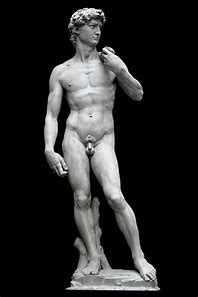Belatedly, I have begun my new year resolutions which are:
1. To keep this blog regularly updated and
2. To recover physically from the injuries inflicted during 2018 – notably the fall and broken arm last August, which put paid to driving a car and walking with Archie for a number of weeks.
By making these resolutions public, I hope to stick to them and to bore readers of this blog with regular progress reports.
Ice on Deeside is making life treacherous for some of us at the moment and I am determined not to hit the ground again this year. Exercise, therefore, must needs be taken inside. At home I have an exercise bike which proudly the displays the logo “Body Sculpture”. Well, we can all dream of that Michelangelo-type figure, which, as luck would have it, is  not unlike my own. As the original of David is readily available on the internet, I don’t need to prove that statement by displaying my personal replica of that magnificence. Here’s what Michelangelo created, so all you need do is simply re-imagine that figure as a Scotsman with a beard.
not unlike my own. As the original of David is readily available on the internet, I don’t need to prove that statement by displaying my personal replica of that magnificence. Here’s what Michelangelo created, so all you need do is simply re-imagine that figure as a Scotsman with a beard.
Stroke survivors, and possibly many others, will recognise the feeling of wobbly legs and total physical exhaustion associated with exercise bikes – and that’s while getting on the bike, let alone the feeling after 5 or 10 minutes hard exercise and then getting off it again.
Having spent several sessions of simply pedalling as fast as possible, both with and without resistance, I have now embarked on the sessions that come pre-programmed into the bike. They are not arranged in level of difficulty, but come in fixed 20-minute blocks with a graph showing the imaginary hills and slopes that have to be negotiated. Program 1 looked the most appealing to me, though I have to say “appealing” is a relative term. All of them look horribly spiky and daunting, but program 1 is displayed as a round fairly even dome rising from the foothills of level 1, ascending via resistance levels 5 and 7 to the summit of killer level 9, before dipping to level 7, then ascending again to the twin peak of level 9, followed by an ever so gradual descent to level 1. No freewheeling allowed. The graph looks something like this:

I am assured by physiotherapists that regularly punishing myself in this way will build up strength and stamina. Because I am an optimist I choose to believe them, although after running through Program 1 for the first time, I was in no fit state to do anything other than collapse and gasp for water. After 20 minutes of seemingly endless pedalling I had negotiated the slopes and allegedly covered a distance of 6.8 kilometres. A few days in, and I have broken the 7 km barrier, and today clocked up 7.15 km. Perhaps the physios are right after all.
The trouble is, this biking on a static bike going nowhere is boring, boring, b-o-r-i-n-g. The devil on my shoulder says “Don’t bother, son.” So either I have to get music, a radio or a personal trainer to keep my interest, or I have to make public the fact that I’m doing it – hence this post.
One of the buzzwords in health care at the moment is self-management. This is the theory that people with long-term conditions, like stroke, can learn to self-manage their condition. Personally, I need that self-management to be supported self-management, because otherwise the will is lacking. In the absence of a personal trainer to provide that support, I ask you, dear reader, to provide that support by making it your resolution to follow this blog through the ups and downs of 2019 – just don’t set your resistance to level 9.
Finally, you may care to read my article about the current state of stroke care in Scotland in this week’s Scottish Review.
